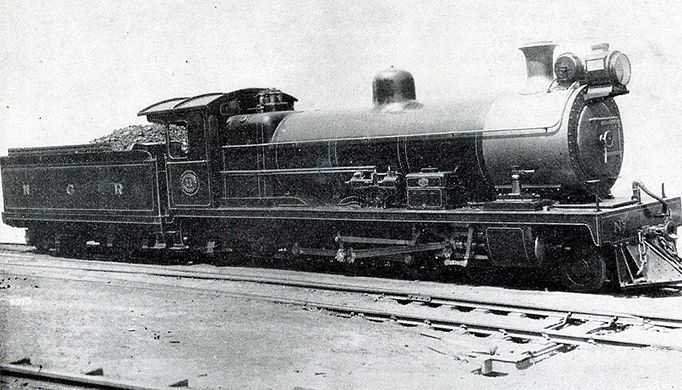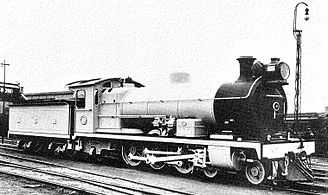South African Class 2C 4-6-2
| South African Class 2C 4-6-2 ex NGR Class A 4-6-2 1910 | |
|---|---|
|
NGR Class A no. 12, SAR Class 2C no. 766 | |
| Type and origin | |
| Power type | Steam |
| Designer | Natal Government Railways |
| Builder | Natal Government Railways [1] |
| Model | NGR Hendrie C |
| Build date | 1910 |
| Total produced | 2 |
| Specifications | |
| Configuration | 4-6-2 "Pacific" |
| Gauge | 3 ft 6 in (1,067 mm) Cape gauge |
| Leading wheel diameter | 28 1⁄2 in (724 mm) |
| Driver diameter | 52 1⁄2 in (1,330 mm) |
| Trailing wheel diameter | 30 in (762 mm) |
| Wheelbase |
Total: 52 ft 7 1⁄2 in (16.040 m) Engine: 6 ft (1.829 m) bogie 9 ft 6 in (2.896 m) coupled 28 ft (8.534 m) total Tender: 4 ft 6 in (1.372 m) bogie 16 ft 6 in (5.029 m) total |
| Length | 60 ft 2.25 in (18.345 m) |
| Height | 12 ft 6 in (3.810 m) |
| Frame | Plate frame |
| Axle load | 15.35 long tons (15.6 t) on 2nd driver |
| Weight on drivers | 45 long tons (45.7 t) |
| Locomotive weight | 69.4525 long tons (70.6 t) |
| Tender weight |
42,392 lb (19.2 t) empty 40.55 long tons (41.2 t) w/o |
| Locomotive and tender combined weight | 110.0025 long tons (111.8 t) w/o |
| Tender type |
TJ * 2 axle bogies * 30 in (762 mm) wheels * Length 22 ft 9.3125 in (6.942 m) |
| Fuel type | Coal |
| Fuel capacity | 6 long tons (6.1 t) |
| Water capacity | 3,500 imp gal (16,000 l) |
| Boiler |
5 ft 0 5⁄8 in (1.540 m) inside diameter 16 ft 11.5 in (5.169 m) inside length 7 ft 4 in (2.235 m) pitch |
| Boiler pressure | 185 psi (1,280 kPa) |
| Firegrate area | 29 sq ft (2.694 m2) |
| Heating surface: – Tubes |
248 tubes 2 in (50.8 mm) diameter 2,101 sq ft (195.189 m2) |
| – Firebox | 121 sq ft (11.241 m2) |
| – Total | 2,322 sq ft (215.721 m2) |
| Cylinders | Two |
| Cylinder size |
19 in (483 mm) bore 24 in (610 mm) stroke |
| Valve gear | Walschaerts |
| Performance figures | |
| Tractive effort | 22,910 lbf (102 kN) at 75% pressure |
| Career | |
| Operator(s) |
Natal Government Railways South African Railways [1] |
| Class |
NGR Class A SAR Class 2C |
| Number in class | 2 |
| Number(s) |
NGR 11-12 SAR 765-766 [1][2][3] |
| Nicknames | Hendrie C |
| Delivered | 1910 |
| First run | 1910 |
| Withdrawn | 1936 [1] |
The South African Class 2C 4-6-2 of 1910 is a South African steam locomotive from the pre-Union era in the Natal Colony.
In 1910 the Natal Government Railways placed two Class A steam locomotives with a 4-6-2 Pacific wheel arrangement in service, built in their Durban workshops. In 1912, when these locomotives were assimilated into the South African Railways, they were renumbered and classified as Class 2C. The 2A and 2B classifications were never used.[1][2][4]
Manufacturer
When more locomotives were required for passenger traffic on the section between Estcourt and Charlestown via Ladysmith on the Natal Government Railways (NGR) mainline, where gradients were less severe than in the coastal region, two locomotives were built in the Durban workshops of the NGR. They were designed by NGR Locomotive Superintendent D.A. Hendrie and were a redesigned version of his NGR Class A of 1905. The Hendrie C, as it was also known, was similar to the Class A Hendrie A in general proportions, but with Walschaerts valve gear, slightly larger diameter driving wheels, a larger boiler and a more enclosed cab that offered better protection to the crew. When they were placed in service in 1910, they were also designated NGR Class A with numbers 11 and 12.[1][4]
Service
The two locomotives joined the two Class A Hendrie A Pacifics of 1905 on the line from Estcourt via Ladysmith to Charlestown on the Transvaal border.[1][4]
The Union of South Africa was established on 31 May 1910, in terms of the South Africa Act, enacted by the Parliament of the United Kingdom. One of the clauses in the Act required that the three Colonial Government railways, the Cape Government Railways, the NGR and the Central South African Railways, also be united under one single administration to control and administer the railways, ports and harbours of the Union. While the South African Railways (SAR) came into existence in 1910, the actual classification and renumbering of all the rolling stock of the three constituent railways required careful planning and was only implemented with effect from 1 January 1912.[2][5]
In 1912 they were renumbered 765 and 766 and classified as Class 2C on the SAR. The 2A and 2B classifications were never used by the SAR.[1][2][4]
After serving on the Estcourt to Charlestown section for many years, they were transferred to the Witwatersrand for a short period, after which they were transferred to the section between Komatipoort and Waterval Boven in the Eastern Transvaal. Here they worked passenger and fast perishables trains until they were withdrawn in 1936.[1][4]
Liveries illustrated
The main picture and the following illustrate two of the NGR liveries that were applied to these locomotives.
-

NGR no. 11, later SAR no. 765, c. 1910
See also
- List of South African locomotive classes
- South African Class 2 4-6-2
- South African locomotive history
- Tender locomotive numbering and classification
- The 4-6-2 "Pacific"
References
|
- ↑ 1.0 1.1 1.2 1.3 1.4 1.5 1.6 1.7 1.8 Holland, D.F. (1971). Steam Locomotives of the South African Railways, Volume 1: 1859-1910 (1st ed.). Newton Abbott, Devon: David & Charles. pp. 102–103. ISBN 978-0-7153-5382-0.
- ↑ 2.0 2.1 2.2 2.3 Classification of S.A.R. Engines with Renumbering Lists, issued by the Chief Mechanical Engineer’s Office, Pretoria, January 1912, pp. 7, 12, 15, 35 (Reprinted in April 1987 by SATS Museum, R.3125-6/9/11-1000)
- ↑ Holland, D.F. (1972). Steam Locomotives of the South African Railways, Volume 2: 1910-1955 (1st ed.). Newton Abbott, Devon: David & Charles. p. 137. ISBN 978-0-7153-5427-8.
- ↑ 4.0 4.1 4.2 4.3 4.4 Paxton, Leith; Bourne, David (1985). Locomotives of the South African Railways (1st ed.). Cape Town: Struik. p. 36. ISBN 0869772112.
- ↑ The South African Railways - Historical Survey. Editor George Hart, Publisher Bill Hart, Sponsored by Dorbyl Ltd., Published c. 1978, p. 25.
